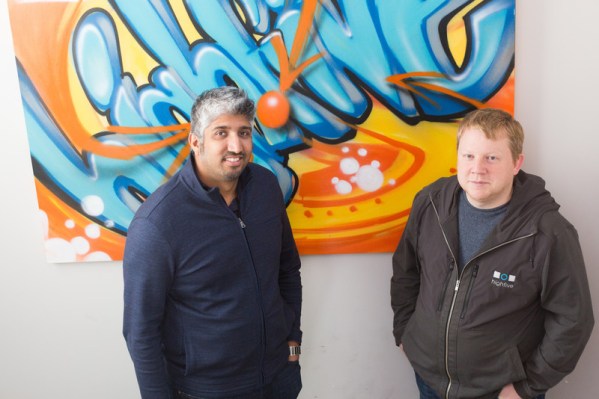With email, phone, SMS, instant messaging, conference calls, and the like, there’s no limit to the number of ways that people today can communicate with each other — and yet, the sheer number of choices and different ways that we try to share information has become a pain point for most organizations.
Well, there’s a new player in town called Highfive that hopes to ease the pain of communications within the workforce, with technology that is rolling out in beta to some enterprise clients. Formerly known as Parlay Labs, Highfive is the brainchild of Docverse founders Shan Sinha and Jeremy Roy.
Docverse, which was all about collaboration, was acquired by Google in 2010 and eventually became the basis for what’s now Google Drive. After spending a few years there, the two decided it was time to venture back into the startup world and do something new.
In doing so, they wanted to help change the way that people in companies communicated and shared information with one another. Sinha tells me that in talking to a number of organizations, whether they be small startups or Fortune 500 companies, all shared the same pain points around communication.
That’s because the tools that we use haven’t changed that much in the last few decades, but the way we work has. Enterprises are now more widely distributed, and employees are taking advantage of new mobility thanks to laptops, smartphones, and tablets. Yet for all that, email and phone and conference calls haven’t fundamentally improved, even while we have more powerful gadgets to run them on.
“Yes, you have email, conference calls, and yes you can get together in person, but we thought that there’s an opportunity to give people a new option,” Sinha said.
With that in mind, Highfive believes there’s an opportunity within the enterprise for a new mode of communication that will take advantage of all the technological advancements that have been made over the past few decades. It’s something that will be able to work on multiple platforms, whether it be desktop, web, or mobile, and eliminate the pain points that most organizations now feel.
So what is it? To be honest, Highfive is still holding its cards close to the chest, and not ready to show off what it’s built — at least not to me.* But it’s spent the last six months cold calling the IT directors and CIOs of organizations of all sizes to test out what it’s built.
According to Sinha, the response has been overwhelmingly positive. “They knew we were solving a big problem… No one we talked to underestimates how big of a pain point this is,” he told me.
As a result, the company has already signed up some major enterprise clients, all of which are paying for the product even while it’s still in beta. Right now it’s in the validation phase of the product, in which it will work with early customers to refine things and get ready for public launch. That launch is expected in mid-2014.
For now, it seems like the solution Highfive has built will work for most organizations — there’s no particular vertical or size of business that its product will best fit. Sinha says that it’s working with companies with as little as 25 or 50 employees, as well as some that have headcount in the tens of thousands.
Anyway, enterprise communications is a big problem, and Highfive has been aggressively hiring to tackle it. The company currently has about 25 employees who have worked at places like Apple, Google, Microsoft, and Jawbone and helped build products like Firefox, the iPhone, Gmail, and Google Apps.** But it’s looking to double that over the next six months as it ramps up its engineering, sales and support teams.
The company has also raised a fair amount of capital: Highfive had previously raised $4 million in seed funding, but brought on an additional $9.5 million in Series A funding from General Catalyst, Andreessen Horowitz and Google Ventures. It also has an impressive list of angels who have put money in, including Salesforce’s Marc Benioff, Dropbox’s Drew Houston, Box’s Aaron Levie, YouTube’s Shishir Mehrotra, and Xobni founders Matt Brezina and Adam Smith.
I look forward to seeing what they’ve built and wish them a whole lot of luck… Because lord knows I’d love to have something to replace all the crappy and kludgy communications tools I’m forced to deal with on a day-to-day basis.
==
* As a side note, I’m personally skeptical of startups that aren’t willing to show off at least a little bit of product before launch, especially when they’re taking on a problem as big as “redefining enterprise communications.” But, hey, the founders have a good pedigree, and it seems like they’ve got some decent traction with early clients, so who knows?
** NBD, right?
